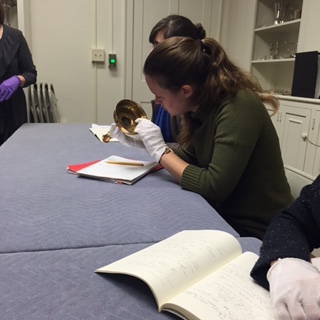Please Touch!
Have you ever seen an object in a museum that you just wanted to touch? Perhaps you wanted to feel its texture or figure out how it functioned? Kept behind velvet ropes or under glass boxes, objects can seem static and disconnected from humanity. But in your hands they come to life.
WPAMC Fellows Kristen and Lan examining an eighteenth century fabric sample book
Our first two Connoisseurship blocks, Furniture and Metals, taught the class of 2017 the true value of a Fellow’s handling privileges. A considerable amount of information can be learned from an object’s show surface, but, as students of material culture, we know to look deeper. You have to take the lid off of the coffee pot, pull the drawers out of a desk, and turn the chair over. You can feel the subtle ridges from a plane used on the bottom of a drawer or feel the hollows of repoussé work on a trophy. There is a certain level of excitement in holding an object created by a famous American craftsman, but it is even more incredible to trace their work and discover how they crafted the object, to see their tool marks or find cleverly hidden joints.
Elisabeth examines the underside of a candlestick
A book can describe how certain regions or different eras used thicker cuts of wood for drawer sides, but it is quite another thing to feel the weight difference in your hands. Or better still to feel the different weights of various cooking pots. Even small cast iron caldrons are quite heavy and cumbersome to move. By feeling the weight of these objects we can form a better understanding of the labor involved in colonial cooking.
Getting a feel for a chair’s intricate carvings
Touch is also important in understanding how people used and interacted with objects. As students exploring Winterthur’s many rooms we frequently find perplexing pieces. During a class session in the End Shop, a group of us became intrigued by an oddly shaped box with leather straps. We puzzled our way through the object, opening little doors and shifting pieces around, until finally we realized it was a travelling peep show. We could have simply looked the object up, but by solving the mystery on our own we were able to recapture some of the object’s magic. We got to experience the same kind of wonder and amusement as the first individuals who saw the peep show.
Tracing a chair maker’s craftsmanship
But you don’t have to be a Fellow in order to feel the excitement of objects. Museums are incorporating elements of touch into their exhibitions and public programs. The Winterthur Museum has an entire room dedicated to reproductions that children and school groups can touch as a playful way to engage with the past. 3D printing has also become an asset to museums for touchable reproductions. So look into your local museum and find your own hands-on experience with the past.
By Alexandra Ward, WPAMC Class of 2017





Leave a Reply